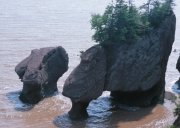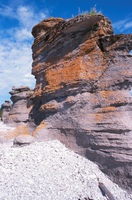
Materials and Processes That Shape A Planet - 6th Grade
Objectives and Indicators for this Unit
2.6.A. Materials and Processes That Shape A Planet
2. Cite evidence to demonstrate and explain that physical weathering and chemical weathering cause changes to
Earth materials.
a. Identify examples of physical weathering, such as the effect of wind, ice, etc. and describe the changes caused in each.
b. Describe the changes in materials caused by each of the chemical weathering processes listed:
▪ Rusting/tarnishing ▪ Dissolving by acid rain
c. Compare physical and chemical weathering and provide examples of changes caused in Earth materials or features by each of these processes.
4. Differentiate among sedimentary, igneous, and metamorphic rocks based upon the processes by which they are formed.
a. Identify and describe the processes that form sedimentary rock.
▪ Deposition ▪ Compaction ▪ Cementation
b. Identify and describe the processes that form igneous rocks
▪ Volcanic eruptions ▪ Igneous intrusions
c. Identify and describe the processes that form metamorphic rocks.
▪ High temperature ▪ Pressure
d. Cite features that can be used as evidence to distinguish among the three types of rocks and relate these features to the processes that form each rock type.
FIRST LARGE ASSIGNMENT
Vocabulary words to look up and put in journal
Weathering
Weathering
Physical Weathering
ASSIGNMENT=Please copy this activity into your journal and complete it there.
PRETEST -Two Kinds of Weathering
1. What is weathering?
 Changes on Earth have been the same throughout time
Changes on Earth have been the same throughout time
 The breaking down of Earth's solid surface
The breaking down of Earth's solid surface
 Rain, snow, sun, and storms
Rain, snow, sun, and storms
 Changes in temperature because of weather
Changes in temperature because of weather
2. What are two kinds of weathering?


3. Which kind of weathering may produce rust?
 Mechanical weathering
Mechanical weathering
 Chemical weathering
Chemical weathering
4. What is the principle of uniformity?


5. Weathering ______.
 Wears down mountains
Wears down mountains
 Makes caves
Makes caves
 Breaks down rocks into smaller rocks
Breaks down rocks into smaller rocks
 All of the above
All of the above
6. Which of these is not a force that causes mechanical weathering?
 Rain
Rain
 Wind
Wind
 Ice
Ice
 The sun
The sun
PRE-TEST - Soil
Physical Weathering
Chemical Weathering
Tarnishing
Rust
Igneous rock
Extrusive
Intrusive
Sedimentary rock
Metamorphic rock
Erosion
Deposition
Compaction
Cementation
Sediment
Silica
Temperature
Pressure
Rock Cycle
| ||||||||||||||||||||||||||||||||||
|
| ||||
|
|
| ||||||||||||||||||||||||||||||||||||||||||||||||||||||||||||||||||||||||||||||||||||||||||||||||||||||||||||||||||||||||||||||
Weathering - The Breakup of Rocks By Patti Hutchison |  |
 1 Air, water, ice, and gravity. These are nature's agents of weathering. Weathering is the breaking down of rocks on the earth's surface. This process has been going on since the earth was formed.
1 Air, water, ice, and gravity. These are nature's agents of weathering. Weathering is the breaking down of rocks on the earth's surface. This process has been going on since the earth was formed.2 Have you seen pictures of the Grand Canyon? Do you know how it was formed? You guessed it- weathering. The water from the Colorado River carved the canyon through the rock around it. Evidence of weathering is all around us.
3 There are two kinds of weathering. The first is mechanical weathering. A mechanic uses tools to take your car apart. Nature uses tools such as ice and water to take rocks apart. This is also called physical weathering.
ASSIGNMENT=Please copy this graphic organizer into your journal and complete it from the reading above
4 Mechanical weathering doesn't change what the rock is made of. It simply changes the size and shape of the rock. There are several ways a rock can be weathered physically.
5 Water and ice are common causes of weathering. Water collects in the cracks of rocks. When water freezes, it expands. This can cause the rocks to split apart. They break down into smaller rocks.
6 Pressure is another tool for weathering. The weight of rock layers on top cause pressure on rocks buried below the surface. Gravity can cause the top layers to be removed. Then the pressure is released. The rocks expand and break apart.
7 Roots of trees and plants can also cause mechanical weathering. They can grow into cracks in rocks. As they do this, pressure on the rocks can cause them to break apart.
8 There is another form of weathering called chemical weathering. Water and oxygen are the most common causes of chemical weathering. They cause chemical changes in rocks.
9 Water can dissolve many kinds of rocks and minerals. Rivers and streams dissolve the minerals in their banks as they move. The rivers become wider or deeper. The minerals are carried away by the current.
10 Oxygen makes up about twenty-one percent of our air. It can combine with many substances. When it does, the chemicals are changed. This is called oxidation.
11 Iron is a substance that is easily oxidized. Iron in rocks and minerals combines with the oxygen in air to form a different substance. If you have a rusty bike chain, you have seen the effects of oxidation.
12 Weathering has a great effect on our lives. Potholes in roads are caused by weathering. Our cars rust. Statues and buildings wear away because of weathering.
13 However, there is a good side to weathering. Weathering helps make soil. Without soil, we would not be able to grow plants for food and to help put oxygen back into the air. Look around you- the effects of weathering are everywhere.
Copyright © 2011 edHelper
ASSIGNMENT=Please copy this graphic organizer into your journal and complete it from the reading above
ASSIGNMENT=Please copy this activity into your journal and complete it there.
Weathering - The Breakup of Rocks
| ||||||||||||||||
|
| ||||
|
| ||||
|
|
Weathering - The Breakup of Rocks
ASSIGNMENT= (fully explain in your journal)
|
Weathering - The Breakup of Rocks
ASSIGNMENT= (fully explain in your journal)
How is weathering harmful to us? How is it helpful?
ASSIGNMENT= (fully explain in your journal)
|
Assignment=Please copy these questions in your journal and complete each sentence using the words in the word list.
|
16. | ____ can devastate land and people by wrecking buildings and flooding cities. | ||||||||||||||||||
17. | The ____ also made volcanoes erupt all over the world. | ||||||||||||||||||
18. | When soil and rocks are moved from one place to another, it is called ____. | ||||||||||||||||||
19. | Big ____ destroy everything in their path. | ||||||||||||||||||
20. | Heavy rainfall can make ____ happen. | ||||||||||||||||||
21. | The color of a mineral in powdered form is the ____. | ||||||||||||||||||
22. | The house was severely damaged by the ____. | ||||||||||||||||||
23. | ____ is what makes canyons. | ||||||||||||||||||
24. | After washing his red Corvette, Antonio admired its ____ in the sunshine. | ||||||||||||||||||
25. | Many ____ form in Kansas and Oklahoma. | ||||||||||||||||||
26. | The movement of Earth's plates can cause ____, volcanoes, and other activities. | ||||||||||||||||||
27. | The stone had a bright ____. | ||||||||||||||||||
28. | ____ occur on fault lines. | ||||||||||||||||||
29. | Scientists use seismographs to study ____. | ||||||||||||||||||
30. | ____ BREAKS DOWN THE EARTH.
| ||||||||||||||||||
Weathering - The Breakup of Rocks By Patti Hutchison |  |
Directions: Fill in each blank with the word that best completes the reading comprehension.
 Air, water, ice, and (1) _______________________ . These are nature's agents of weathering. Weathering is the breaking down of rocks on the(2) _______________________ 's surface. This (3) _______________________ has been going on since the earth was formed.
Air, water, ice, and (1) _______________________ . These are nature's agents of weathering. Weathering is the breaking down of rocks on the(2) _______________________ 's surface. This (3) _______________________ has been going on since the earth was formed.Have you seen pictures of the Grand Canyon? Do you know how it was (4) _______________________ ? You guessed it- weathering. The water from the Colorado River carved the canyon through the rock around it. Evidence of weathering is all around us.
There are two kinds of weathering. The first is (5) _______________________ weathering. A mechanic uses (6) _______________________ to take your car apart. Nature uses tools such as ice and water to take rocks apart. This is also called (7) _______________________ weathering.
Mechanical weathering doesn't change what the rock is made of. It simply changes the size and shape of the rock. There are several ways a rock can be weathered (8) _______________________ .
Water and ice are common causes of weathering. Water collects in the cracks of rocks. When water freezes, it expands. This can cause the rocks to split apart. They break down into smaller rocks.
Pressure is another (9) _______________________ for weathering. The weight of rock layers on top cause pressure on rocks buried below the surface. Gravity can cause the top layers to be removed. Then the pressure is released. The rocks expand and break apart.
(10) _______________________ of trees and plants can also cause mechanical weathering. They can grow into cracks in rocks. As they do this, pressure on the rocks can cause them to break apart.
There is another (11) _______________________ of weathering called chemical weathering. Water and oxygen are the most common causes of chemical weathering. They cause chemical changes in rocks.
Water can (12) _______________________ many kinds of rocks and minerals. Rivers and streams dissolve the minerals in their banks as they move. The rivers become wider or deeper. The minerals are carried away by the (13) _______________________ .
Oxygen makes up about twenty-one percent of our air. It can (14) _______________________ with many substances. When it does, the chemicals are changed. This is called(15) _______________________ .
Iron is a substance that is (16) _______________________ oxidized. Iron in rocks and minerals (17) _______________________ with the oxygen in air to form a different substance. If you have a rusty bike chain, you have seen the effects of oxidation.
Weathering has a great effect on our lives. Potholes in roads are caused by weathering. Our cars rust. Statues and buildings wear away because of weathering.
(18) _______________________ , there is a good side to weathering. Weathering helps make soil. Without soil, we would not be (19) _______________________ to grow plants for food and to help put oxygen back into the air. Look around you- the effects of weathering are everywhere.
Copyright © 2011 edHelper
ASSIGNMENT=Please copy this activity into your journal and complete it there.
Weathering - The Breakup of Rocks
| ||||||||||||||||
|
| ||||
|
| ||||
|
|
GLACIERS - MECHANICAL?PHYSICAL WEATHERING
GLACIERS
Glaciers are huge ice sheets that slowly move. They not only transport material as they move, but they also sculpt and carve away the land beneath them. The ice totally changes the landscape. The ice erodes the land surface and carries the broken rocks and soil far from their original locations.
Glaciated valleys are probably the most visible landform caused by the movement of glaciers. Like fjords, they are trough-shaped, often with steep vertical cliffs where entire mountainsides were removed by glacial movement. One of the most striking examples of glaciated valleys can be seen in Yosemite National Park, where glaciers literally sheared away mountainsides, creating deep valleys with vertical walls
Glaciated valleys are probably the most visible landform caused by the movement of glaciers. Like fjords, they are trough-shaped, often with steep vertical cliffs where entire mountainsides were removed by glacial movement. One of the most striking examples of glaciated valleys can be seen in Yosemite National Park, where glaciers literally sheared away mountainsides, creating deep valleys with vertical walls
ASSIGNMENT=Please copy this graphic organizer into your journal and complete it from the reading above
ASSIGNMENT=Please copy this graphic organizer into your journal and complete it from the reading above
ASSIGNMENT=Please copy this activity into your journal and complete it there.
| ||||||||||||||||
Assignment=Please double click this site and
learn about how glaciers change a landscape
http://phet.colorado.edu/en/simulation/glaciers
Hit "run" Then play with the simulation
Please write 6-10 notes in your journal about
what you learned from this glacier simulation.
PART #2
learn about how glaciers change a landscape
http://phet.colorado.edu/en/simulation/glaciers
Hit "run" Then play with the simulation
Please write 6-10 notes in your journal about
what you learned from this glacier simulation.
PART #2
6th Grade -Materials and Processes That Shape a Planet -6th Grade
2.6.A. Materials and Processes That Shape A Planet 2. Cite evidence to demonstrate and explain that physical weathering and chemical weathering cause changes to Earth materials. a. Identify examples of physical weathering, such as the effect of wind, ice, etc. and describe the changes caused in each. b. Describe the changes in materials caused by each of the chemical weathering processes listed: ▪ Rusting/tarnishing ▪ Dissolving by acid rain c. Compare physical and chemical weathering and provide examples of changes caused in Earth materials or features by each of these processes. 4. Differentiate among sedimentary, igneous, and metamorphic rocks based upon the processes by which they are formed. a. Identify and describe the processes that form sedimentary rock. ▪ Deposition ▪ Compaction ▪ Cementation b. Identify and describe the processes that form igneous rocks ▪ Volcanic eruptions ▪ Igneous intrusions c. Identify and describe the processes that form metamorphic rocks. ▪ High temperature ▪ Pressure d. Cite features that can be used as evidence to distinguish among the three types of rocks and relate these features to the processes that form each rock type. e. Describe the processes that change one form of rock into another (rock cycle).
| ||||||||||||||||||||||||||||||||||||||||||||||||||||||||||||||||||||||||||||||||||||||||||||||||||||||||||||||||||||||||||||||||||||||||||||||||||||||||||||||||||||||||||||||||||||||||||||||||||||||||||||||||||||||||||||||||||||||||||||||||||||||||||||||||||||||||||||||||||||||||||||||||||||||||||||||||||||||||||


















No comments:
Post a Comment